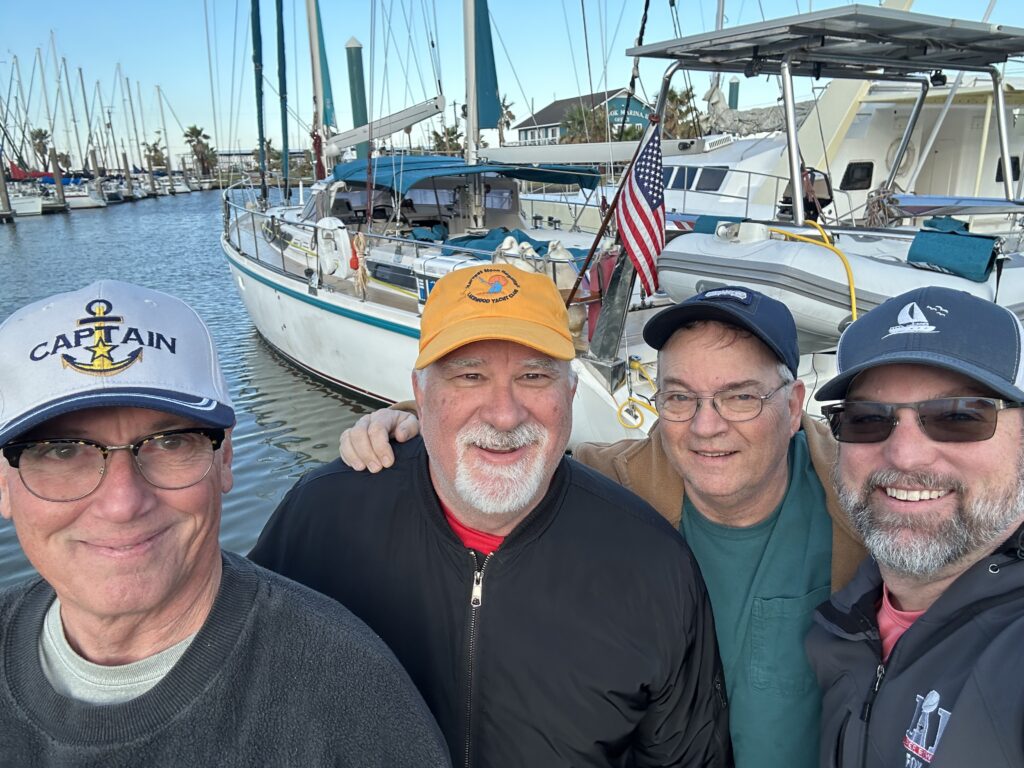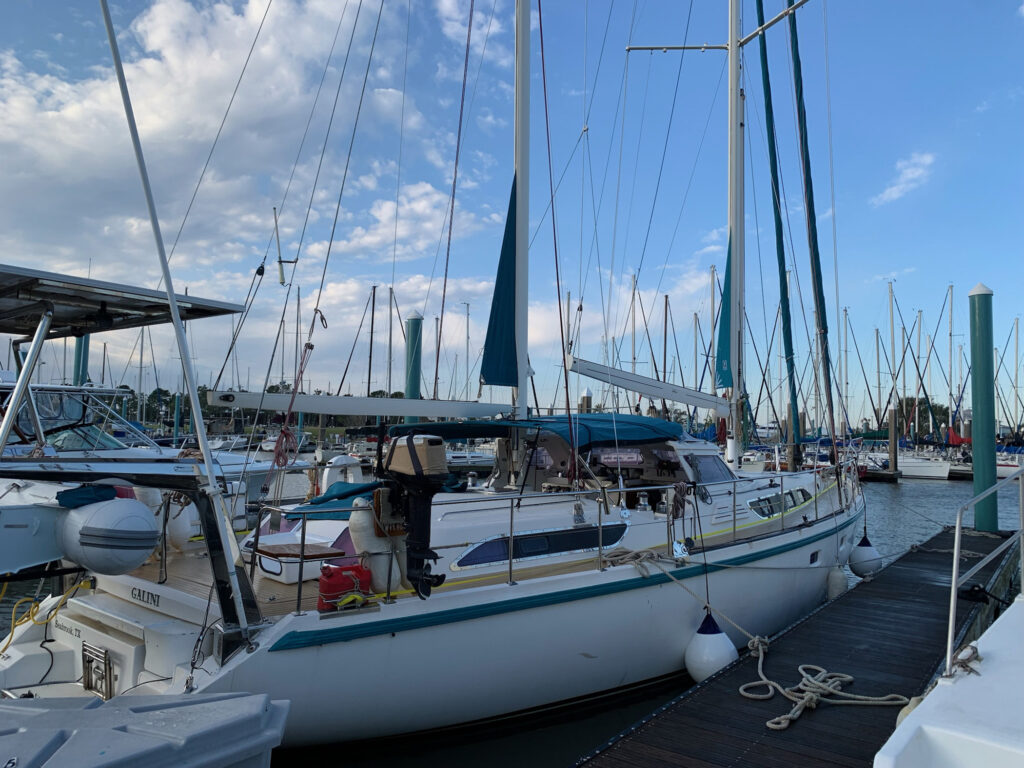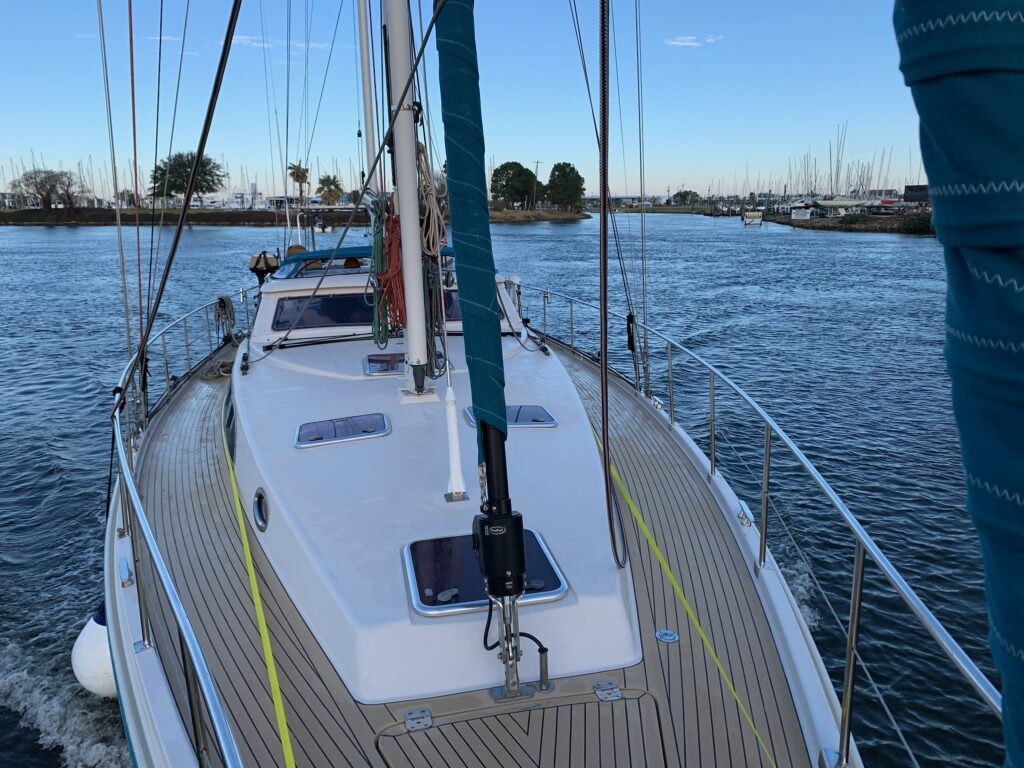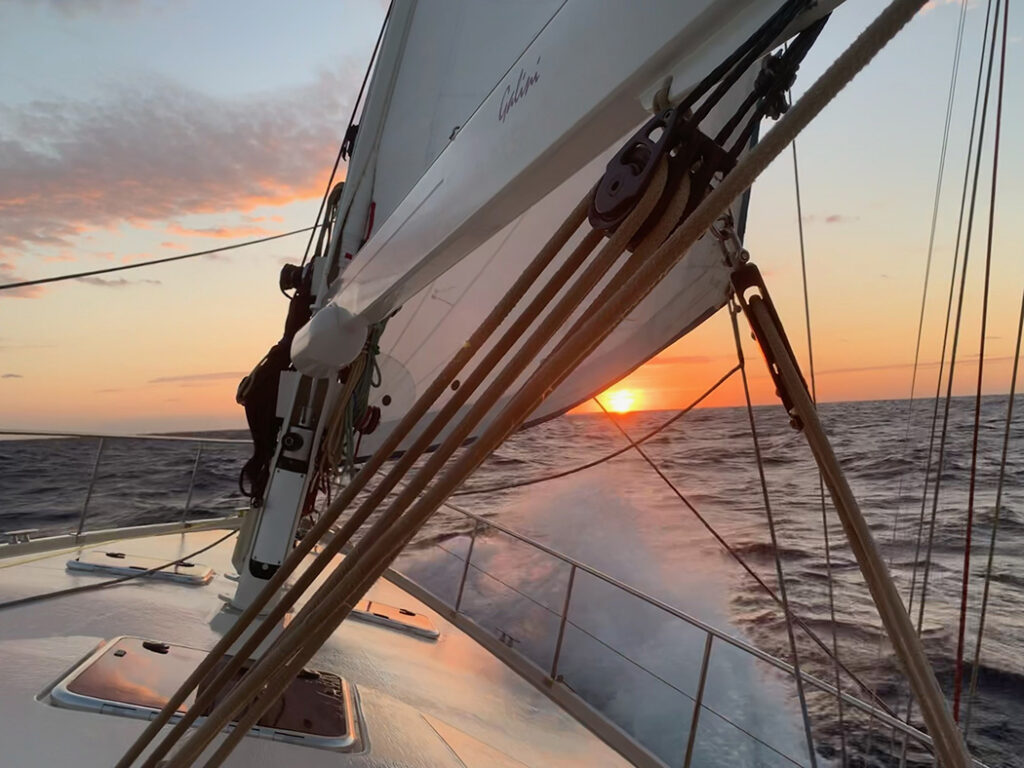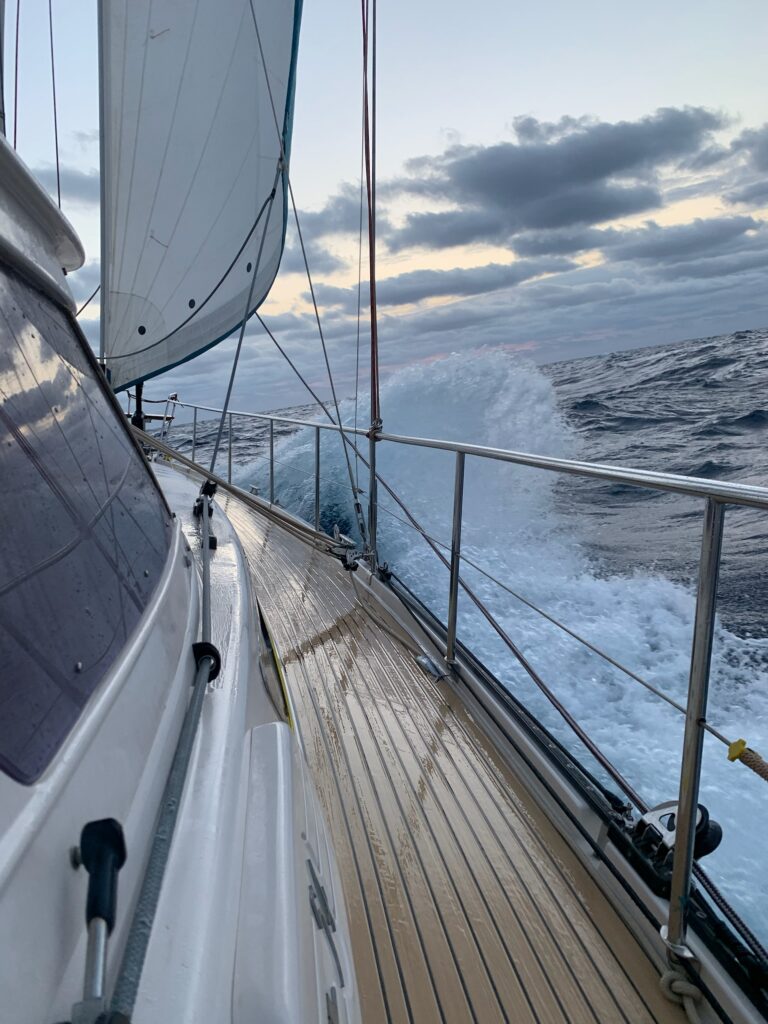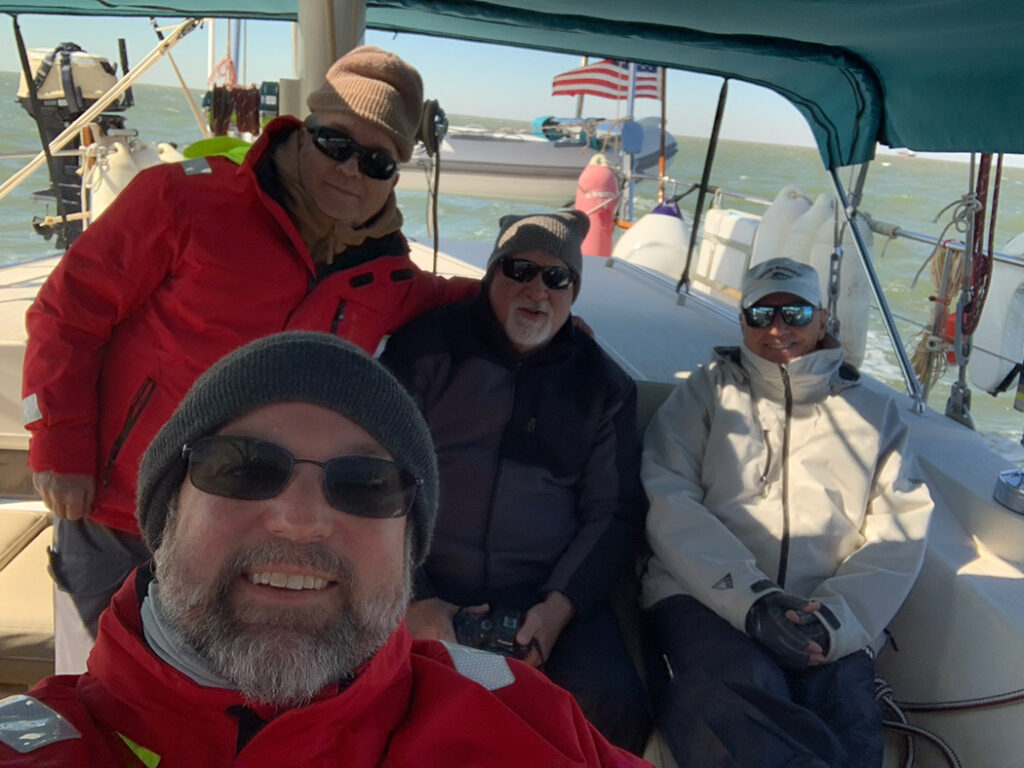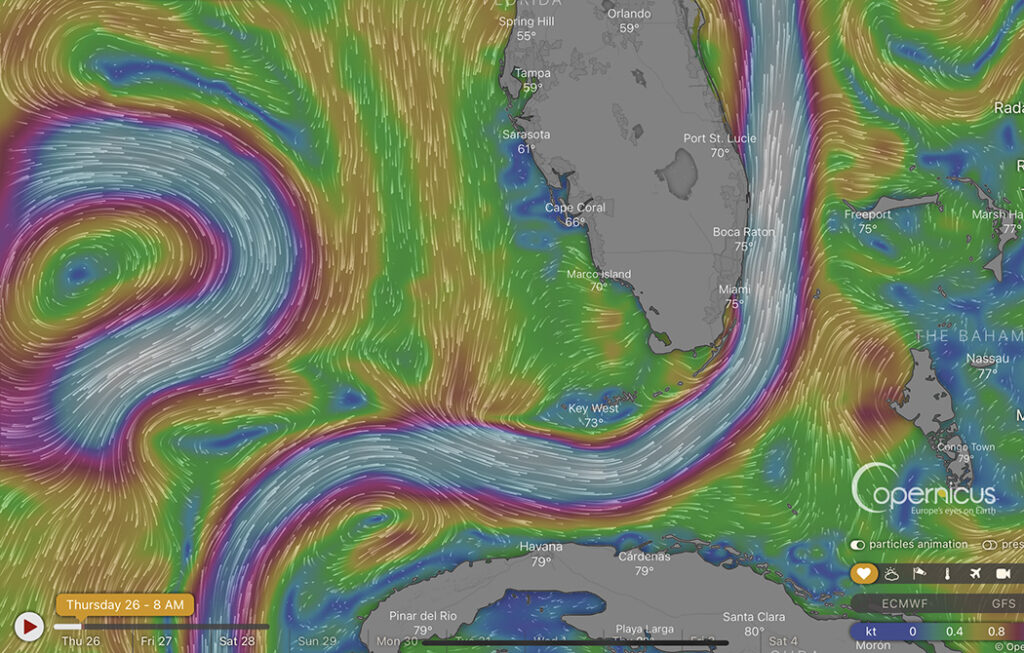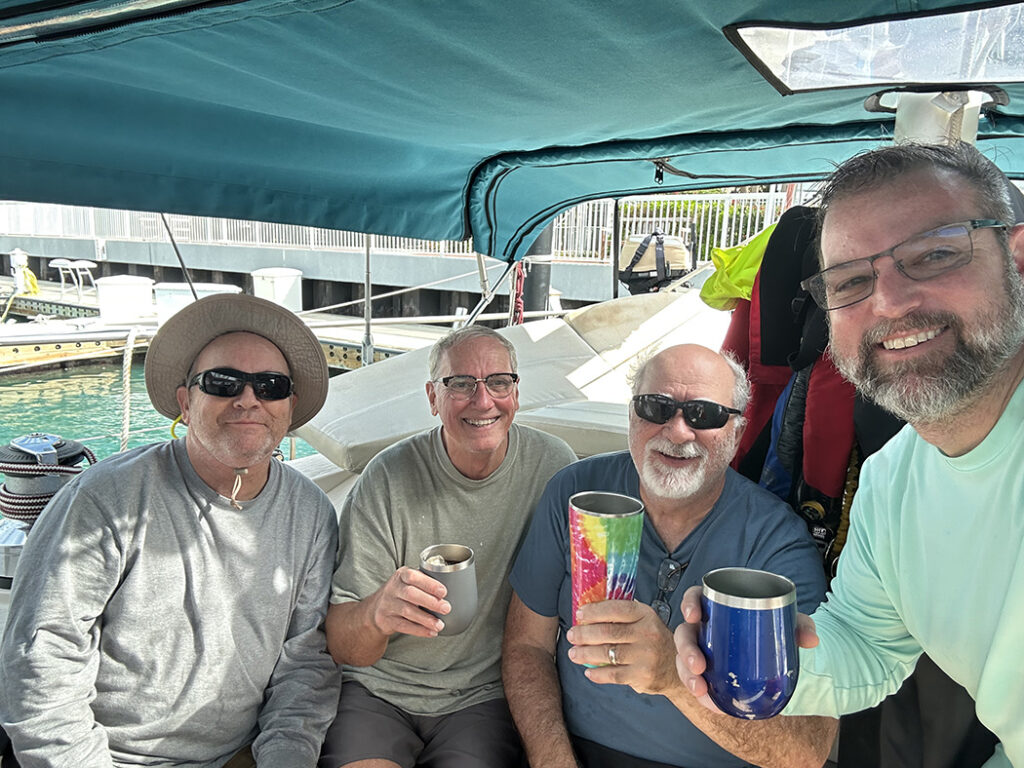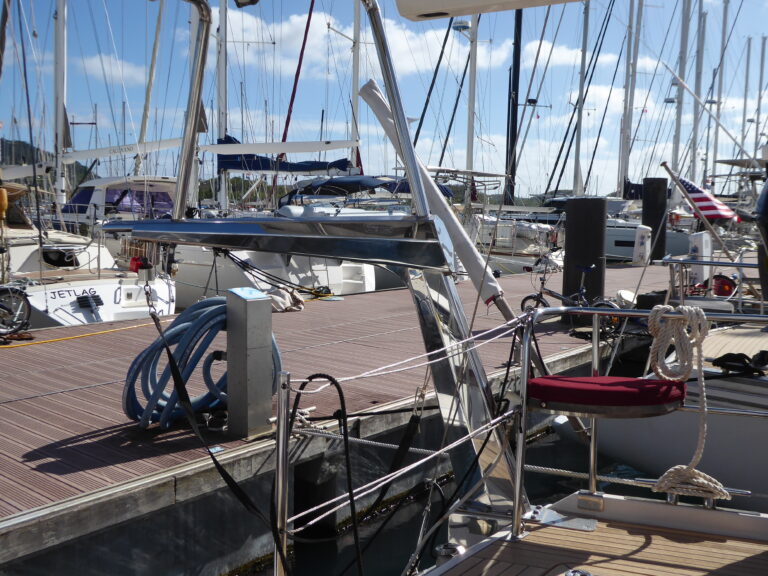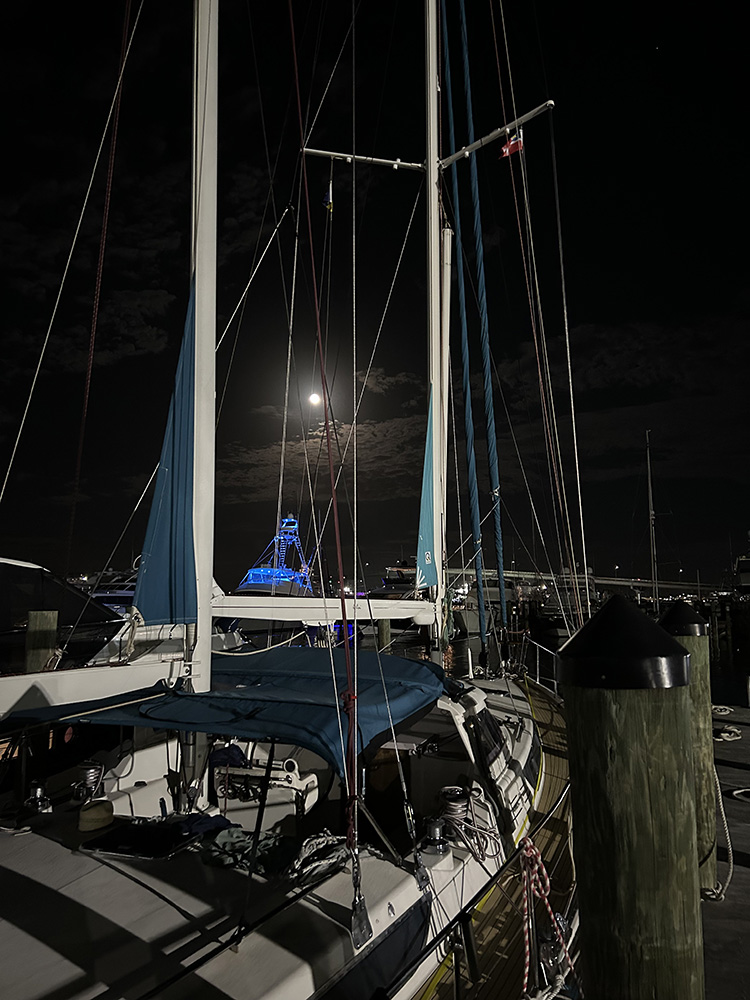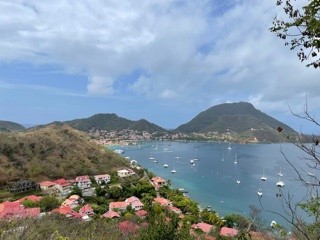We set sail at daybreak on a late January morning bound for Nassau Bahamas. We had delayed departure by day waiting for strong north winds and steady rain to die down, but a chill breeze remained with overcast sky. It was the kind of day that demands a hot cup of coffee, long sleeved layers, and a waterproof slick. This was the type of weather that wakens one’s spirit, like stepping away from a warm fire into an encompassing crisp nature’s breath. Chilly yes, but we were all warmed by anticipation for the passage that lay ahead. Lines cast, engine purring, we slipped away from Galini’s home dock in Seabrook Texas bound for the open sea. The next five hours were full of excited chatter and boat adjustments as we were confined to motor venture down the Houston ship channel into the Galveston cut. As we rounded through the intersecting harbor, it was time to hoist the sails and push out past the jetties into the Gulf of Mexico. We set a full mizzen and a full genoa. It was a busy Sunday morning, with a number of small boats, barges, tankers, and container ships running up and down the channel. Another hour on and we were past the final GA buoy and into open water.
Galini was on her shakedown passage. The previous six months had entailed an extensive refit since purchasing her in Martinique then sailing her to Seabrook for continuation of a refit of her rigging, engine, sails, electronics, and comfort features. But now, at long last, Galini was ready to face her new adventures with a new owner. Of course, we had been monitoring the forecast closely for the past week. For days the weather routing guides had been indicating that a deep ranging front would start to move out of the central Gulf toward the east coast. That system packed some pretty strong wind with significant rain, but was forecast to clear out of the Gulf by week’s end. Our plan was to follow the front out of Galveston and steer SE for the first 200 miles. We then intended to tack over and grab onto the more southerly flow that was forecast to fill in behind the front. That would give us favorable winds and a wonderful reach all the way to Florida. If those predictions held, we could expect pleasant sailing conditions for the whole trip. However, predictions are just that, predictions, and our reality would prove quite different.
The first day was exciting for all of us. We had four souls aboard. Larry Brown had sailed on Galini the previous Spring bringing her to Seabrook from the Cayman Islands. Since then, Larry had helped immensely on Galini’s refit and he was becoming a good friend. Larry had adopted the role of Galini’s electronics guy: experienced, insightful, and patient. Most of all patient. It seems to me that new technology devices are increasingly failing in human factors engineering. What’s the deal GUI developers? Nearly every new platform on a competing device has a divergent interface that must be learned from scratch. Menus buried in menus, none of them intuitive. Maybe younger generations are used to this and accept it as the norm. But in the beginning of the tech revolution, there was much more emphasis placed upon the human intelligent use of the machine, rather than the machine dictating to the human. Is that really necessary? Could not the industry decide on an underlying set of design structures to guide development of new interfaces, they are in fact, intuitive? It would seem advantageous that when developers build upon the successful utilizations that people found easily adaptable, new technology would be quickly be rapidly more productive and meaningful. Fun to use, you know? So, Larry is patient. He takes deep dives into the endless roots of submenus then guides me through their use. He has heard me rant about these issues many a time and yet we remain friends.
In addition to Larry, two new friends were aboard, Scott Wright and Jim Miller. Both were experienced sailors and eager for the adventure of a Gulf crossing. Together, Galini was in fine hands. Temperatures remained fresh as we snaked our way SE through the offshore oil fields. The upper Gulf coast area is populated by numerous production rigs and pumping platforms, along with the associated service vessels passing to and fro. At night, these unworldly beacons of light appear as glows on the horizon, then become brilliant shining cities in an aquatic wilderness. Throughout the morning and into the afternoon on our first day at sea, the winds remained steady at 17 knots and the seas were low at 3 – 5 ft. Superb sailing conditions. Our weather route was laid in and we were following it pretty close. Our plan was to sail to Key West, pretty much along the rhumb line, where we would lay over a day and Jim would fly home due to family obligations. Scott, Larry and I would then continue on to Nassau. There is a large clockwise circular gyre in the eastern Gulf, north of Cuba, off the west coast of Florida. Our route had us pointing SE, then E, to catch the northern edge of the clockwise current flow. Currents in the gyre can reach 2 knots or more, so being in the top of the clockwise flow would move us along toward Florida favorably. At the bottom of the gyre the current is directed toward Galveston, so on top is where one wants to be.
We had provisioned well before leaving Seabrook. Following a long seafaring tradition, the first night out called for a good meal. I jumped below and prepared sauteed chicken quarters in a tomato sauce with green chili peppers. That paired with wasabi mashed potatoes and a lovely Greek salad. I was always told by more experienced cruising sailors that if one can cook aboard, one should. Sometimes that requires flattening the boat, by turning down wind a while or even drifting while heaving to. These small gifts of patience on a longer passage are well worth it. Putting this type of patience into practice reflects a principal tenant of the new philosophy of life I have recently adopted. The philosophy itself is not new, it has been around and developed through practice my many for about a century. It is a way to live through grace and humility. There are but a few tenants. One key principle guiding the path to a richer existence is to learn how to listen. Listening is not easy I find. It is a skill that must be honed, and like an infinite onion, has layers upon layers that can be peeled away to reveal fresh insights underneath. Listening for me involves setting aside my personal ego and preconceived expectations, particularly about people and what they carry inside. We all have bias, we all have judgements, we all have faults. I remember my grandfather telling me as a young boy, that listening is more powerful than talking. Listening opens the door into another person’s spirit. He would say, “look another man in the eye, listen to his thoughts, and there you will find his truth.” Wow. I find it fascinating that although lessons like that resonated, the greater understanding of their message remained enigmatic. But listening is not limited to conversation. There is a wealth of knowledge to be gained from reading, hearing the experiences of others, and meditating on their wisdom gained. And there is still more. I find it increasingly wonderful to listen to the world’s nature, to hear the beauty in the vast diversity of life, to wonder at the paradoxes that bind together our universe, and to comprehend the message constrained by human capacity from a power greater than myself. This type of listening demands humility. I find a grace in that, a grace that my father and grandfather carried in their lives. Funny, only after they both have passed on and I grow older, do I now seek to unravel the hidden intricacies of what they gifted.
During dinner, we set the night watch. I like a staggered watch schedule. With four of us, we had the luxury of each person being able to serve a three hour watch solo. Personally, I favor the early morning times at sea (often called the dog watch), so for the first night I took the 2 -5 am shift. Larry had the 11pm – 2am slot, Jim the 8pm – 11pm, and Scott the 5 -8 am. The stagger in the schedule begins on day 2, where each person slides back in time by one watch slot. Thus, on the second night Larry had 8 – 11pm, I had 11pm -2am, Scott had 2 – 5am, and Jim rotated to 5 am– 8 am the next day. The staggering in the schedule continues for as many days as one is at sea. This schedule has the advantage that everyone stays fresh by getting some sleep over the passage and no one person is always stuck in the same watch slot for the entire trip. Each person also gets to experience different daily epochs at sea which adds to the experiential diversity.
Following dinner, it was time to download updated GRIB files and check the forecast. The winds were picking up, 22 knots now and the sea state was increasing. Consistent with those observations, the new forecast was surprisingly different than just a day before. The cool front we had planned on chasing had been pushed southeastward and was dissipating. Behind it was a much larger rapidly forming northern front stretching across the southern states pushing down from Louisiana. The new front showed outer bands reaching east to Pensacola and west to Galveston and carried increasing winds from the NE. The forecast showed it would press deep into the Gulf and get stronger over the next 24 hours, much stronger. No worries at this point though, instead of a beam reach, we would just be sailing a narrow reach with more wind. I had not sailed Galini close to the wind much yet, so this would be new experience for all of us.
True to the forecast, as the hours progressed into the evening and night the wind steadily increased. By midnight, we were in the mid-twenties and creeping upward. Seas were increasing too, but in the dark of a new moon with a solid cloud cover, the surround remained invisible until the sea was breaking over the bow. One thing was certain, waves were cresting now in an unpredictable manner and were intermittently timed. Galini was beginning to pound which spelled out a tough night ahead. True enough, by the time my watch hit, winds were in the high 20s sustained and gusts in the low thirties. The sea was becoming much more confused and waves were crashing over the bow with water rising at times up to the dodger. It was becoming a rough ride.
Next morning as dawn broke, we could see that the sea state had deepened. Swells were high, often reaching 10 ft. Confusion in the sea was the word. Crests would whisp and fly in the wind as waves broke headed for Galini’s bow. We had already reduced head sail to the second reef during the night and were flying jib and jigger. Galini was sailing at 8.5 – 9 knots, but often slowed as a wave would push her bow high into the air and then leave her to fall into the passing trough. Pound in these instances she would, shaking the boat with a terrific crashing sound. As anyone whom has tried to hold an upwind course in these conditions knows, comfort is not the state of affairs. It is difficult to move around above or below. Cooking, sleeping, and other necessary functions are a challenge. And that really is the key. The boat can easily handle the weather, although of course, it is hard on gear. It is seldom dangerous, but these conditions make for long stark passages. It tires the crew and a tired crew make mistakes.
As the sun rose, conditions rapidly deteriorated. Temperatures were dropping so we donned more layers. By mid-morning winds were steady at 28 knots, gusting into mid-thirties with high frequency. In order to keep our course, we had to hug an acute wind angle and point as high as possible. Strange, but I felt a sense of both pride and consternation as I marveled at Galini’s ability to point reasonably high and plow through the sea in these conditions, she is a heavy cruising ketch after all. Being 16 feet abeam and weighing in at 40,000 lbs., Galini thrust through the rising seas fair enough. However, winds had whipped the waves up to 8 – 10 ft with 12 – 15 s intervals, so the pounding was more frequent and sea more violent. These are not severe conditions by any means, but they are tough going when compounded days on end.
We downloaded new weather GRIBS. It was not cheering news. The changing models showed even more hardened conditions to come. Just north of us and all along our intended route the winds were predicted to increase into the upper thirties sustained. A little further north and winds were in the forties sustained. Waves would soon be reaching 10 – 12 ft with 10 – 12s intervals. It felt like we were experiencing waves of that magnitude already, judging by the water height above the deck as Galini bottomed in the troughs. Occasionally, we would bottom out in a trough where the ensuing peak was just below the bottom spreader. That would be a 20+ ft or so wave. I had certainly been in worse conditions before, but not in this boat and not that often. Amel builds strong ocean cruisers, so I had confidence in Galini’s heavy weather performance. But the wind forced one to pay attention to any sail manipulation and the seas commanded one’s respect, no matter the task.
An hour more and the sea was becoming less predictable. Large waves would pick up Galini’s bow and leave her airborne, only to crash into the following trough with a terrific slamming sound. The rigging would shake. You could feel the boat decelerate to a crawl, then quickly gain back her losses while rising up the next crest. When the larger waves came, approaching 14 – 16 ft or so, they often appeared in triplets. One very large wave followed by 2 to 3 smaller after-shock waves. Each was sufficient to push Galini’s bow into the air, bucking bronco style. I’ve heard it said that the Gulf can turn into a washing machine in a storm. Aptly true this trip. Most of the waves came from port bow, but sometimes they would crash over the port side, or even come from the port stern! These occurrences were wet affairs. Even though Galini has a well-protected center cockpit with deep coamings, these large waves coming from the side or behind would pour significant spray into the cockpit and often over us. Occasionally, water would bury Galini’s bow and cover the front half of the boat reaching all the way up to the dodger. This is when one appreciates the Amel protected cockpit design and hard dodger surround that serve together to keep the water out. Galini was our home and she was taking a pounding by the sea. To paraphrase Jack Aubrey, “quick was the word and sharp was the action”.
We decided to take in more sail. After furling to the third reef point, the genoa sheet was being tightened and we heard a loud sound emanate from the rigging and the genoa sail began flogging. What was that? On Galini, each of the sail sheets are composed of a single continuous line, with an eyelet sown in the middle by thick seizing strands. During the last furl of the genoa, the lazy sheet side had been left tight on the opposing winch by mistake. When the loaded sheet side was being winched in, the lazy side remained tight, essentially pulling the loop seizing apart. Now, there were just a few threads holding the eyelet together. If it let go, the sheet would be free to slide through the clew of the sail. There would be no way to adjust the sail and it would be a challenge to furl it. We would be forced to lower the sail and take it off the furler. No small feat in the current conditions. To gain an understanding, one must appreciate that the size of the genoa and the forces involved. Galini’s genoa is a behemoth 170% sail cut of heavy cruising cloth. It would be tough for 2 people to handle the sail in moderate conditions, but these were anything but. So, we quickly furled the genoa while we still could, then unleashed the staysail. Thoughts of changing the genoa sheet consumed our conversation. With the sail furled, the clew reached up 10 or so feet off the deck, so we could not reach it. That meant we would have to unfurl it to some extent to get to the clew and replace the damaged sheet. This we tried, but no matter which direction we pointed the boat, the magnitude of the wind would either fill or flog the sail with such force that it was unmanageable by hand, even with 2 or 3 people. Jim suggested that we rig a barber-haul to the genoa sheet and try to winch in the clew. Good idea. Larry and I went up on deck to implement the plan but were thwarted during several attempts to wrangle in the sail. We again considered lowering the genoa to replace the sheet. That would mean motoring into the wind in order to unfurl the sail completely, then release the halyard and drop the sail to the deck. With the crashing waves, pounding deck, and higher winds, we rejected that idea as too much risk. The sail could get washed over the side of the boat, the pounding bow would be difficult to hang on to, and it would take at least 2 people full effort for some time, and maybe 3. In this wind, falling off to lower the sail was also not an option. We settled on leaving the genoa furled. After all we still had the staysail, main, and mizzen. Our close wind ability would be reduced and we had at least 3 – 4 days of sailing left to get to Key West, but so be it.
We kept going. By 2 pm, it was clear that maintaining our current course was unfounded. I did not want to be beating into the weather front for another 3 days at the least and perhaps more. Our options included going back to Galveston and wait for a better weather window. In that direction, the wind would be less severe and, on the beam, but we were over 24 hours away and Jim would have to abandon the trip because of time constraints. We could alternatively tack over and run into New Orleans, but that option would put us on a close reach into even stronger wind, destination at least 20 hours away. Third option, go south. That course would point us toward Mexico on a broad reach and flatten the boat, even though we would be adding distance and time to our trip. It took all of two minutes to make the decision. Helm over: new course 180 degrees True. We flung out the reefs. Galini took off flying along at 9 – 10 knots, surfing down the following seas. It looked as though 18 – 24 hours on that course would get us out of the worst weather and hopefully the northern front would move eastward allowing us to resume our route to Key West. What a relief. Galini was happier and so were we.
That evening, the winds were still high but on a broad reach the boat motion was more comfortable. The waves were still confused however, and random large crests would knock Galini in unpredictable directions. Water over the stern was common, sometimes wave crests would shower us in the cockpit under the canvas, but that was rare. I decided to cook anyway just before sundown. The crew had a good laugh at the ensuing chef acrobatics, flying food bits, and swearing being staged from the galley. Eventually, we were able to provide a pretty nice dish of onions, mushrooms, and garlic seared in olive oil followed by a generous folding of Bok choi. The mix was seasoned with a healthy dose of curry powder and a dash of soy sauce. As with many meals on Galini, tortillas serve as a bread substitute. A little cultural diversity is always a good thing.
For the entire third night of the passage, we ran south. The winds behind us remained strong but the sea was following and Galini was racing along. At daybreak on day four, we checked the GRIBs and saw that the heaviest of the weather north of us had dropped from forty knot winds to just above thirty. By running south, we had escaped the worst of the headwind. In fact, we were experiencing sustained winds only in the upper twenties. The seas were still running 8 – 10 feet but they were on our port quarter not our bow. Still, we needed to go to Key West, not central Mexico. During the 20 hours that we had sailed south, we had buried nearly 160 miles of water under our keel. The weather prediction was that by midday, we could resume our eastward push with winds in the lower twenties. We decided to heave to, sit tight for a while and let the waves die down a little. Then, around noon on day 4, we tacked back into the wind on course for Key West. Since we were we had lost our power genoa, our speed was low and that meant added time in the confused seas. We decided to motor sail. That diesel sail gave us the extra needed power to push through the confused seas and maintain our needed close hauled wind angle. Still, the sea state remained high as the northern winds had been building the swells for several days and they wouldn’t dissipate for some time to come. Pounding again we were, although not as severe as the preceding days. Although the galley was manageable, we were tired. Dinner that night consisted of sandwiches, spicey pretzels, and apples. Later that evening, an empty package of chocolate chip cookies appeared in the trash.
Morning of day five. GRIBs showed that the northern front was dissipating. Our GPS located us pushing into the western edge of the Gulf current gyre. Since we had run south to escape the storm, we were now sailing through the lower third of the circular flow where we were finding a foul current moving westward against us. Winds remained in the low twenties and to keep our speed up we continued to motor sail. We were hovering at five knots with the engine at 1400 rpm, but that was enough to keep us on our route for the rest of the day. At sunset, a filling meal was welcomed by all. The galley was easily manageable, although not free of random motion, as the seas had slackened to 4 – 6 feet with a longer period. Our menu consisted of pasta arabiatta and smoked sausage. That coupled with a healthy salad containing romaine lettuce, south Texas grape tomatoes and cucumber, as well as banana peppers. The mix was plentifully sprinkled with feta cheese, olive oil and balsamic vinegar. The crew mood was in full cheer; Key West was approaching and we should make port by morning.
As night fell, we passed to the north of the Dry Tortugas and were well into the shallow waters of the Florida Keys. Fishing boats, pleasure boats, and ship traffic increased in frequency. We found ourselves maneuvering around the various paths of the isolated vessels all headed to nearby destinations. Around 2:30 am near the Marquesas Keys, we encountered two boats that were on parallel paths to us just ahead moving at speeds slightly less than ours. Both carried standard navigation lights, one white all round, stern, and sidelights. We approached to pass to their starboard stern and they began turning into us, so I dropped down on a lower southern course to stay astern. One of them then turned the opposite direction as we approached while the second boat kept turning across our path, essentially cutting me off. I identified them on the AIS and hailed them; no response after several tries. We were getting within a half mile of them, so I changed course 180 degrees to pass to port. Just as we were turning we received a radio hail from one of the boats telling us they were fishing with nets and had the right of way so could we please change course. That was immediately followed a brilliant green laser from his stern pointed at our boat. Whomever it was whisked the laser up and down our hull and sails for at least half a minute. This was repeated by a second radio hail for us to change course. Since I had changed course twice 180 degrees opposed from each other I was at a loss as to what they wanted from us. Go back West? That I would not do. I checked again and saw no red or green lights above the all-round white, so no indication of a fisher/trawler. I pushed the throttle to 1800 rpm. More laser target tag. All of this was happening in about 4 – 10 meters of water, so I was a little nervous about what lay ahead. After 20 minutes it was over. As we distanced beyond them, I questioned what I had done in error. What action on my part would have avoided being a source of consternation for them? I still am unsure.
At 5 am, we were closing the channel entrance into the western approach to Key West. The cruising guide indicated a healthy dose of caution at this point, so we dopped sails and drifted until the sun rose. An hour or so later, motor engaged, we saw another sailboat coming out of the channel towards us, so we reversed their track and went into the Key West harbor. We pulled into the Opal Key Marina, just behind the cruise ship dock. A very nice spot with small shops and walking access to Key West town. Galini’s breakout passage was a genuine test of her capacity. We celebrated with a night on the town after giving Galini a good wash and stowing gear. The next morning, we hauled out the genoa and replaced the parted sheet. Lessoned learned for the future: weather uncertainties abound and the seas can be a mess on an eastward Gulf passage in January. One thing for certain, it was a memorable ride.
